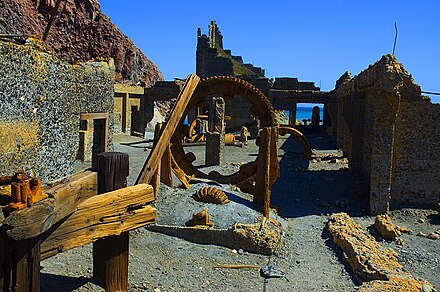White Island - island volcano in New Zealand's Bay of Plenty
White Island (Maori: Whakaari) is an uninhabited active volcanic island off the coast from Whakatane in the Bay of Plenty in New Zealand that you can sometimes land on by boat or helicopter, or overfly on fixed-wing aircraft.
Since 9 December 2019, tours have been suspended and there is no visitor access to the island due to an eruption.

Understand
Whakaari/White Island is the only active marine volcano near New Zealand's main islands. It is 48 kilometres off the east coast of the North Island, in the Bay of Plenty. The nearest mainland towns are Whakatane and Tauranga. The island is roughly circular and about 2 km in diameter. The volcano is around 100,000 to 200,000 years old and about two thirds of it is hidden below sea level. There are three distinct craters, only one of which is active, and it has a small crater lake.
The full Maori name for the island is 'Te Puia o Whakaari' meaning literally 'The Dramatic Volcano'. Captain Cook named it White Island in 1769 as he saw a large white cloud, not realising that it was steam from volcanic activity.
Sulphur was mined on Whakaari in the late 1800s and early 1900s, but mining was abandoned after a landslide and lahar in 1914 killed all the workers. Mining resumed in the 1920s and '30s, and the remains of the buildings can still be seen, much corroded by natural sulphuric gases.
The volcanic activity is constantly monitored by volcanologists from the Institute of Geological and Nuclear Sciences. Survey pegs, magnetometers and seismographic equipment for early earthquake warnings via radio have been installed on the crater walls, along with visual surveillance cameras. Visitors have been known to place small objects in front of the crater webcam, with a small, pink toy dinosaur the star. Hourly updates can be seen on two GeoNet webcams.
The sulphuric fumes and acidic environment ensure that there is very little vegetation within the crater. Eruptions in 1981–83 altered much of the island’s landscape and decimated the extensive pohutukawa forest on the outside of the main crater wall. The crater that formed then filled to became a lake. When it is not too active it is possible to get close to yellow and white sulphur crystal formations and bubbling fumaroles capped with steam.
The island was bought by George Raymond Buttle in 1936 and is now owned by the Buttle Family Trust. It was declared a private scenic reserve in 1953. In 1997 the Buttles appointed the owners of White Island Tours as official guardians of the island.
Get in

By boat
- White Island Tours (PeeJays), White Island Rendezvous, 15 The Strand East, Whakatane, +64 7 308-9588, info@whiteisland.co.nz. Daily, weather permitting. The trip to the island takes about 80 min. Inflatables are used to ferry visitors to the jetty. The guided tour on the island is 1.5–2 hr. Allow 5–6 hr for the round trip. Refreshments and lunch are included. Per person: $229. 21 Jan to 19 Dec, children 13 years and under are $130 and babies under 1 year are free of charge
By plane
- Frontier Helicopters, 216 Aerodrome Rd, Whakatane Airport, Whakatane, +64 7 308-4188, info@frontierhelicopters.co.nz. Helicopter trips landing on the island depart from Whakatane Airport daily and are weather dependent. Peak season departure times are 08:00, 10:00, 12:00, 14:00, 16:00. $650 per person (minimum of 2)
- Helipro. Helicopter trips landing on the island depart from Tauranga and Rotorua.
- Volcanic Air Safaris, Rotorua City Lakefront, Memorial Dr, Rotorua, +64 7 348 9984. Helicopter trips landing on the island cost from $835. Floatplane flights (that overfly the island but do not land) cost from $595.
Fees and permits
Visitors can land only with permission and must not disturb or remove anything. The four authorised tourist operators have the necessary permit to land you.
Get around
See

- The ruins of the sulphur factory. They are scattered throughout the crater, and some are accessible enough for you to walk into. Most are accompanied by grisly stories of how their inhabitants died from poisoning or landslides.
- The crater lake. A lake of brilliantly green, hot, steaming sulphuric acid. Don't get too close to the edge!
- Sulphur encrusted fumeroles. As the sulphur comes out of the ground, it forms striking yellow towers, many of which are still active and billow with sulphuric fumes.
Do
Buy
Eat
Drink
Sleep
Stay safe
This is an active volcano with toxic fumes, hot gases and corrosive chemicals. The tour operators will have checked the activity alert level but still, in December 2019, 22 visitors died and more were injured when the volcano erupted and tours have been suspended since then.
If you are concerned, consult the experienced guide. Do not go anywhere on the island without them. First aid and safety equipment is provided. Wear fully-enclosed shoes with good grip – not sandals or jandals.